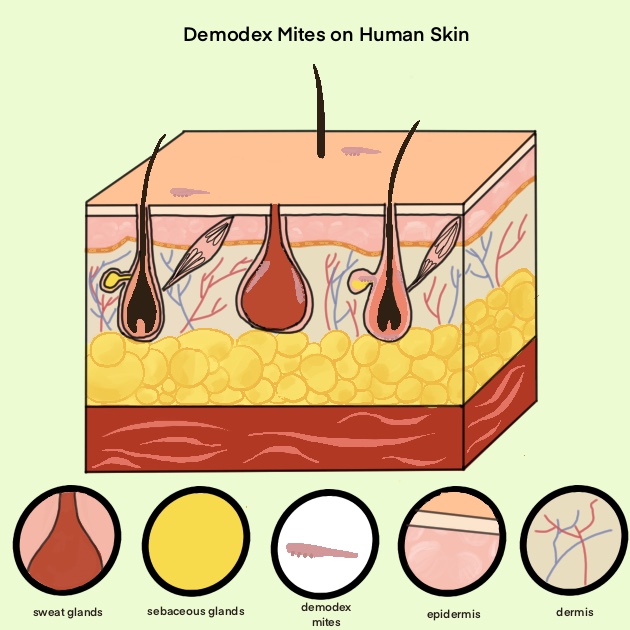Though the thought may sound gross to some, chances are, legions of mites – tiny eight-legged creatures – reside on your face. But you’re not alone. Nearly everyone you know is infested with them as well.
These microscopic tenants are parasites called Demodex mites. There are two different species that can inhabit the face: Demodex folliculorum and Demodex brevis. They live in the hair follicles and in the sebaceous glands of your skin and eyelashes, where they feed on your cells. Although they usually aren’t harmful, they can cause inflammation of the facial skin with redness and pimples. On the eyelids, eyelashes may fall out. They are also likely responsible for papulopustular rosacea (PPR), a common skin condition that causes inflamed red bumps and pimples on the face.
Since mites inhabit everyone’s skin, why do some have flawless complexions while others do not? Shouldn’t most people experience rosacea? Fabienne Forton, M.D., a dermatologist based in Brussels, Belgium, has studied Demodex mites for 37 years and may have contributed to the answer. She explains in the skin, “there is a subtle balance between the [growth of the] parasite and its human host who has to control [the growth].” Some factors that favor its proliferation may occur to help the mites grow, such as having large sebaceous glands.
From the [mites’] point of view, well-developed sebaceous glands are a luxury hotel with a very good restaurant,” said Dr. Forton.
But other factors may also influence their proliferation. These include having a specific type of rosacea (erythmatotelangiectactic rosacea) that causes facial redness or a defect of the host’s immune defense.
Large mite populations attack the follicle wall mechanically and chemically, causing cellular stress and cellular destruction. At the same time, they also produce large amounts of antigens. The clinical manifestation then becomes dependent on another factor: the balance between two opposing immune reactions induced by the mites.
On one side, the mites are able to stifle the host’s immunity for their own benefit, in order to multiply. If this predominates, the clinical manifestations are very discreet, giving rise to the “pityriasis folliculorum”, with white follicular scales at the basis of the small hair on the face, usually associated with a red face. But, on the other side, the mites also stimulate the host’s immune system, inducing an immunogenic reaction to try and stop the growth of the mites. When the body’s reaction is inefficient and things get out of control and exaggerated, pimples appear, resulting in PPR.
Although the existence of these skin-munching mites may come as a shock, don’t worry! They are typically harmless and don’t cause symptoms in most people. Even if you do have PPR, there are many effective treatments available now and also in development to help keep your complexion healthy and clear.
- Microscopic eight-legged parasites called Demodex mites live on the human face.
- These tiny animals live in the hair follicles and in the sebaceous glands of our skin and eyelashes, where they feed on our cells.
- Demodex mites can cause inflammation of the facial skin with redness and pimples. They are also likely responsible for papulopustular rosacea (PPR), a common skin condition that causes inflamed, red bumps and pimples on the face.
- Presence of these mites can stimulate the host’s immune system, inducing an immunogenic reaction to try and stop their growth. But when the body’s reaction is inefficient, pimples appear, resulting in PPR.
- The good news is that there are many effective PPR treatments available now and also in development.
Sources
- Asli Turgut Erdemir, Mehmet Salih Gurel, Ayse Esra Koku Aksu,Tugba Falay, Esma Inan Yuksel, Ebru Sarikaya. ”Demodex mites in acne rosacea: reflectance confocal microscopic study”. March 11, 2016.
- Cheryl Guttman Krader, BS, Pharm. ”Subclinical mite proliferation linked with erythematotelangiectatic rosacea”. December 9, 2019.
- Fabienne Forton. “Papulopustular rosacea, skin immunity and Demodex: pityriasis folliculorum as a missing link”. October 24, 2011.
- Interview with Dr. Fabienne Forton M.D. Interview by Juhi Amin. August 14, 2020.
- Nathalia Murilloa, Jérome Aubert, Didier Raoult. “Microbiota of Demodex mites from rosacea patients and controls”. April 8, 2014.
Editorial Team
- Chief Editor: Shivani Patel
- Team Editor: Justin Huang
- Creative Team Manager: Maya Hofstetter
- Social Media Team Manager: Karishma Goswami
- Image credits: Daniela Benoit
Mentor
Content Expert
Dr. Fabienne Forton, M.D. is a dermatologist in private practice in Brussels, Belgium. She first became interested in Demodex mites at the Catholic University of Louvain. She has done clinical research on Demodex mites and rosacea in collaboration with the Université Libre de Bruxelles (University in the City of Brussels, Belgium).


